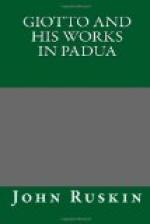One point more remains to be noticed respecting him. As far as I am aware, he never painted profane subjects. All his important existing works are exclusively devoted to the illustration of Christianity. This was not a result of his own peculiar feeling or determination; it was a necessity of the period. Giotto appears to have considered himself simply as a workman, at the command of any employer, for any kind of work, however humble. “In the sixty-third novel of Franco Sacchetti we read that a stranger, suddenly entering Giotto’s study, threw down a shield, and departed, saying, ’Paint me my arms on that shield.’ Giotto looking after him, exclaimed, ’Who is he? What is he? He says, “Paint me my arms,” as if he was one of the BARDI. What arms does he bear?’"[7] But at the time of Giotto’s eminence, art was never employed on a great scale except in the service of religion; nor has it ever been otherwise employed, except in declining periods. I do not mean to draw any severe conclusion from this fact; but it is a fact nevertheless, which ought to be very distinctly stated, and very carefully considered. All progressive art hitherto has been religious art; and commencements of the periods of decline are accurately marked, in illumination, by its employment on romances instead of psalters; and in painting, by its employment on mythology or profane history instead of sacred history. Yet perhaps I should rather have said, on heathen mythology instead of Christian mythology; for this latter term—first used, I believe, by Lord Lindsay—is more applicable to the subjects of the early painters than that of “sacred history.” Of all the virtues commonly found in the higher orders of human mind, that of a stern and just respect for truth seems to be the rarest; so that while self-denial, and courage, and charity, and religious zeal, are displayed in their utmost degrees by myriads of saints and heroes, it is only once in a century that a man appears whose word may be implicitly trusted, and who, in the relation of a plain fact, will not allow his prejudices or his pleasure to tempt him to some colouring or distortion of it. Hence the portions of sacred history which have been the constant subjects of fond popular contemplation have, in the lapse of ages, been encumbered with fictitious detail; and their various historians seem to have considered the exercise of their imagination innocent, and even meritorious, if they could increase either the vividness of conception or the sincerity of belief in their readers. A due consideration of that well-known weakness of the popular mind, which renders a statement credible in proportion to the multitude of local and circumstantial details which accompany it, may lead us to look with some indulgence on the errors, however fatal in their issue to the cause they were intended to advance, of those weak teachers, who thought the acceptance of their general statements of Christian doctrine cheaply won by the help of some simple (and generally absurd) inventions of detail respecting the life of the Virgin or the Apostles.




